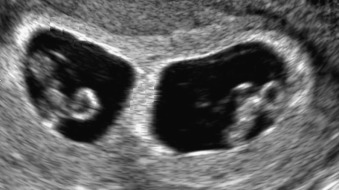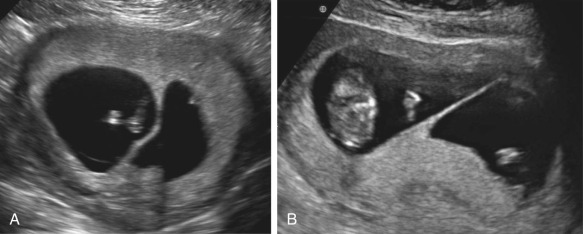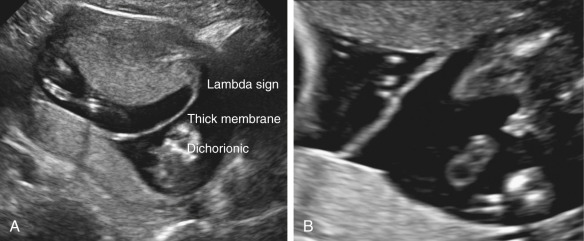Abstract
The term dichorionic refers to a multiple gestation with two distinct placental disks (or two chorions); the term diamniotic describes a pregnancy with two distinct amniotic cavities. Either monozygotic or dizygotic twinning can result in a dichorionic diamniotic twin gestation. In the early first trimester, dichorionic diamniotic twin pregnancies can be identified by the presence of two distinct gestational sacs separated by a thick dividing membrane, each containing a separate fetal pole, yolk sac, and amniotic sac. Dichorionic pregnancies have a thick intertwin membrane and a characteristic thick triangular projection of placenta between the layers of the dividing membrane known as the twin peak or lambda sign. The finding of two distinct placental masses each with a cord insertion or the finding of discordant fetal gender is almost always diagnostic of a dichorionic twin gestation. Prenatal ultrasound (US) is essential in the management of dichorionic twin pregnancies to allow determination of chorionicity, evaluation of fetal anatomy, and serial US assessment of cervical length and fetal growth.
Keywords
dichorionic, diamniotic, twin, multiple gestation
Introduction
Twin pregnancies account for more than 3% of live births in the United States. Determination of chorionicity and amnionicity is essential in the clinical management of multiple gestations. Although dichorionic twin gestations are not associated with as many fetal complications as monochorionic gestations, all twin pregnancies, whether dichorionic or monochorionic, have an increased risk of adverse pregnancy outcomes compared with singletons. Ultrasound (US) plays a vital role in prenatal determination of chorionicity and in the management of dichorionic diamniotic twin pregnancies.
Disease
Definition
The term dichorionic refers to multiple gestations with two distinct placental disks (or two chorions), and the term diamniotic describes a pregnancy with two distinct amniotic cavities. A dichorionic diamniotic twin pregnancy is a twin pregnancy in which each fetus has its own placenta and amniotic sac.
Prevalence and Epidemiology
Twin gestations accounted for more than 3% of live births in the United States in 2007. Dichorionic diamniotic twin gestations comprise most twin births.
Etiology and Pathophysiology
Twinning can occur from either the fertilization of multiple ova or the division of a single fertilized ovum into more than one fetus. The terms monozygotic and dizygotic refer to the number of ova responsible for a twin gestation. A monozygotic pregnancy results from a single fertilized ovum that divides into two distinct fetuses. In contrast, dizygotic pregnancies originate from the fertilization of two separate ova and are genetically dissimilar. The frequency of monozygotic twins is constant worldwide at 4 : 1000 births. In contrast, the frequency of dizygotic twins varies by maternal age, parity, family history, maternal weight, nutritional state, and race.
Either monozygotic or dizygotic twinning can result in a dichorionic diamniotic twin gestation. Dizygotic pregnancies are almost always dichorionic diamniotic, with each fetus having its own placenta and amniotic cavity. In contrast, chorionicity of monozygotic gestations is determined by the time at which division of the fertilized ovum occurs. If twinning occurs during the first 2 to 3 days, it precedes the separation of cells that eventually become the chorion and results in a monozygotic dichorionic diamniotic pregnancy. After approximately 3 days, twinning cannot split the chorionic cavity, and division of an ovum results in monochorionic placentation. Among spontaneously conceived same-sex dichorionic twins, approximately 18% are monozygotic.
Manifestations of Disease
Clinical Presentation
Multifetal gestations should be suspected if the uterine size is greater than expected. Similarly, the possibility of a multiple gestation should be considered if elevated concentrations of maternal serum analytes, such as beta-human chorionic gonadotropin, alpha-fetoprotein, and other serum aneuploidy markers, are noted in the first or second trimester. When a multiple gestation is suspected clinically US should be performed to assess plurality, and if a multiple gestation is confirmed, to determine chorionicity and amnionicity. There are no non-US clinical findings that can differentiate dichorionic from monochorionic twin gestations prenatally.
Imaging Technique and Findings
Ultrasound.
In the first trimester, dichorionic diamniotic twin pregnancies can be easily detected on US. Between 6 and 10 weeks’ gestation, a dichorionic diamniotic twin pregnancy can be identified by the presence of two distinct gestational sacs separated by a thick dividing membrane, each containing a separate fetal pole, yolk sac, and amniotic sac ( Fig. 161.1 ).

Later in the first trimester and in the second trimester, dichorionic pregnancies can be differentiated from monochorionic pregnancies through a systematic evaluation of the placental number, fetal gender, and insertion of the intertwin membrane into the placenta. When examining the insertion of the intertwin membrane into the placenta, dichorionic pregnancies show a thick triangular projection of placenta between the layers of the dividing membrane. This finding, known as the twin peak or lambda sign , has a sensitivity greater than 97% and specificity of 100% in predicting dichorionicity ( Fig. 161.2 ). In addition, the finding of two distinct placental masses ( Fig. 161.3 ) each with a cord insertion or the finding of discordant fetal gender is almost always diagnostic of a dichorionic twin gestation. In a study of more than 400 twin pregnancies undergoing US at less than 24 weeks’ gestation at a single tertiary care center, evaluation of placental location, membrane insertion, or fetal gender resulted in accurate prenatal diagnosis of chorionicity in greater than 95% of cases.












